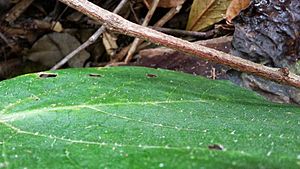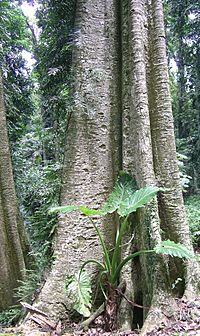Giant stinging tree facts for kids
Quick facts for kids Giant stinging tree |
|
|---|---|
 |
|
| Chewed leaf of a Dendrocnide excelsa at Gumbaynggirr State Conservation Area, west of Nambucca Heads, Australia | |
| Scientific classification | |
| Genus: |
Dendrocnide
|
| Species: |
excelsa
|
The Dendrocnide group has 37 different kinds of shrubs and large trees. They are part of the Urticaceae family, also known as the nettle family. These plants are famous for being "stinging trees."
Dendrocnide excelsa, often called the Australian nettle tree, fibrewood, gimpi gimpi, giant stinging tree, or gympie, is a rainforest tree found in eastern Australia. You can find it from Tathra, New South Wales all the way up to Imbil in southeastern Queensland. It is very common in places like Dorrigo National Park and other rainforest areas in eastern Australia. This giant stinging tree likes to grow in subtropical, warm temperate, or coastal rainforests. It especially thrives in areas that have been disturbed, for example, by storms or cyclones.
Contents
What Happens if You Get Stung?
Every part of this tree that is above ground has stinging hairs. If these hairs touch your skin, they can cause a very strong reaction. This makes the tree dangerous for animals, travelers, and campers. However, the tree is a very important part of the natural environment in eastern Australian forests.
The sting from Dendrocnide excelsa is thought to be worse than the sting from the Dendrocnide photinophylla. But it is not as bad as the sting from the Dendrocnide moroides, which is known as the gympie stinger.
This tree releases special proteins called gympietides. These are a type of neurotoxin, which means they affect the nervous system. Scientists have found that these proteins are similar to toxins found in spiders and cone snails. This was a new discovery because these types of toxins had not been seen in plants before. Researchers think that the long-lasting pain from gympietides might happen because they cause lasting changes in the pain-sensing nerves.
The venom from the tree attaches to and activates pain sensors in your nervous system. By understanding how these proteins work, scientists hope to create new medicines for pain relief.
A small sting might only hurt for an hour or two. However, a very bad sting can cause pain for many months. If you get stung, the first aid is to use wax hair-removal strips. You press them onto the skin where the hairs are, then quickly pull them off to remove the tiny stinging hairs. Dendrocnide stings have been known to seriously harm animals like dogs and horses if they brush against them. Even thick welding gloves did not protect researchers from stings when they were studying the tree.
How to Identify the Giant Stinging Tree
Dendrocnide excelsa is a medium to large tree. It can grow over 40 meters (about 130 feet) tall. The base of the tree often has wide, strong supports called buttresses. These can be more than 6 meters (about 20 feet) wide at the bottom.
The trunk of the tree can have grooves or ridges. The outer bark is smooth and gray, with a few corky marks. The trunk and its buttresses have smooth, even curves. The leaves grow in an alternating pattern along the branches. They are heart-shaped and have jagged edges. In shady areas, the leaves can be very large, sometimes over 30 centimeters (about 12 inches) long and wide. Leaves that grow in the sun are smaller. Many insects, like the chrysomelid beetle, and some mammals eat these leaves, even though they are full of stinging hairs.
Flowers and Fruit
The flowers of the giant stinging tree appear from November to April. They grow in short clusters called panicles. The fruit is a purple or blackish nut. It ripens between March and August. The fruit's soft part can be eaten, but it is not safe for humans to eat because of the stinging hairs. Many rainforest birds, such as the regent bowerbird and the green catbird, enjoy eating the fruit.
Traditional Uses
Indigenous Australians used the strong fibers from this tree. They would use these fibers to make nets and lines for various purposes.



